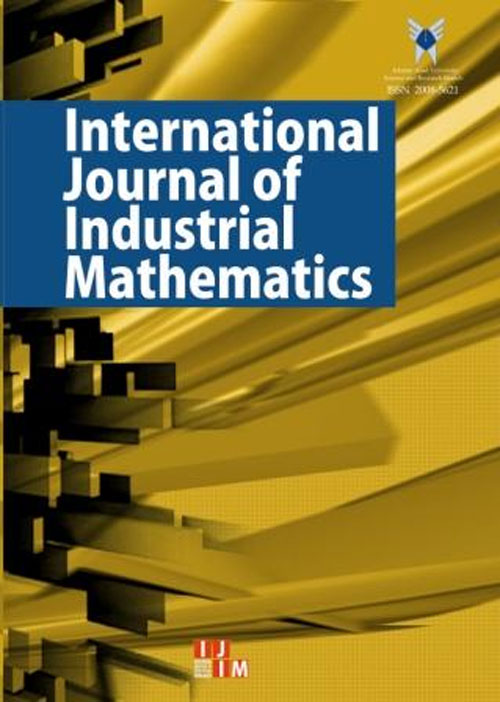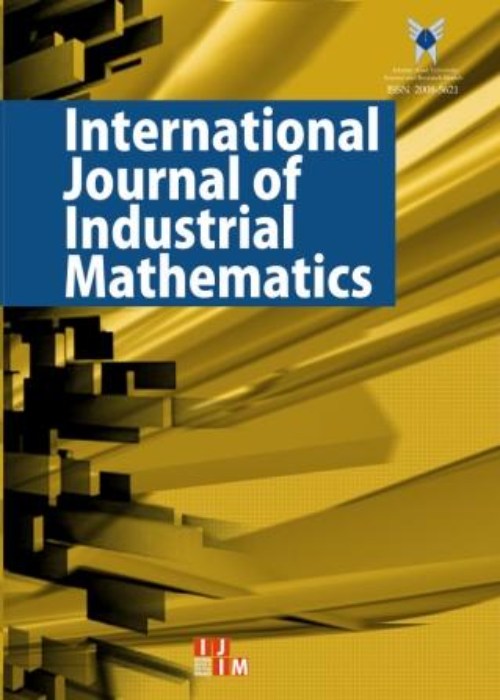فهرست مطالب

International Journal of Industrial Mathematics
Volume:12 Issue: 1, Winter 2020
- تاریخ انتشار: 1398/10/11
- تعداد عناوین: 10
-
-
Pages 1-11
This paper addresses a type of fully fuzzy bilevel linear programming (FFBLP) wherein all the coefficients and decision variables in both the objective function and constraints are triangular fuzzy numbers. This paper proposes a new simple-structured, efficient method for FFBLP problems based on crisp bilevel programming that yields fuzzy optimal solutions with unconstraint variables and parameters. some examples have been provided to illustrate these methods.
Keywords: Bilevel linear programming, Triangular fuzzy numbers, Ranking function, Optimal solution, Unconstrain variables -
Pages 13-21
Several authors have proposed different methods to find the solution of fully fuzzy linear programming (FFLP) problems. But all the existing methods are based on the assumption that all the fuzzy coefficients and the fuzzy variables are non-negative fuzzy numbers. in this paper a new method is proposed to solve an FFLP problems with arbitrary fuzzy coefficients and arbitrary fuzzy variables, that is, there is no restriction on the elements that have been used in the FFLP problems. By using the radius of gyration function (ROG) we show that fuzzy solution obtained of solving FFLP problems, is exact fuzzy optimal solution of FFLP problems. The introduce method are very easy to understand and to apply for fully fuzzy linear systems occurring in real life situation.
Keywords: Fully fuzzy linear programming, Exact fuzzy optimal solution, Ranking function, Radius of gyration -
Pages 23-30
In this article, a new scheme inspired from collocation method is presented for numerical solution of stiff initial-value problems and Fredholm integral equations of the first kind based on the derivatives of residual function. Then, the error analysis of this method is investigated by presenting an error bound. Numerical comparisons indicate that the presented method yields accurate approximations in many cases in which the collocation method is failed.
Keywords: Local annihilation method, Residual function, Stiff problems, Ill-posed problems -
Pages 31-42
The main purpose of this study was to investigate employees and managers’ satisfaction of transportation system in the steal and rolling Units of Saba in Mobarakeh Steel Company using the intuitionistic fuzzy data. The statistical population included the personnel of Saba Steel and Rolling Units from Mobarakeh Steel Company including 1800 people.
Keywords: Fuzzy numbers, Personal satisfaction, Intuitionistic fuzzy numbers, Defuzzification -
Pages 43-57
In this paper, the investment portfolio is formed based on the data mining algorithm of CHAID on the basis of the risk status criteria. In the next step, the second investment portfolio is created based on the decision rules extracted by the DEA-BCC model. The final portfolio is created through a two-objective mathematical programming model based on the Imperialist Competitive algorithm.
Keywords: data mining, Classification, DEA Based CHAID, Imperialist Competitive Algorithm, Stock Selection -
Pages 59-70
This paper has been worked on a RAP with multi-state components and the performance rate of each component working state may increase by spending technical and organizational activities costs. Whereas RAP belongs to Np-Hard problems, we used Genetic algorithm (GA) and simulated annealing (SA) and for solving the presented problem and calculating system reliability universal generating function (UGF) have been used.
Keywords: Reliability optimization, Redundancy allocation problem, Multistate components, universal generating function, Genetic algorithm -
Pages 71-79
A new iteration scheme for computing the sign of a matrix which has no pure imaginary eigenvalues is presented. Then, by applying a well-known identity in matrix functions theory, an algorithm for computing the geometric mean of two Hermitian positive definite matrices is constructed. Moreover, another efficient algorithm for this purpose is derived free from the computation of principal matrix square root. Finally, several experiments are collected.
Keywords: Iterative methods, HPD, Sign function, Stability, Convergence -
Pages 81-88
Performance measurement with undesirable outputs is an important subject in production processes. There are papers in which works can be divided into two groups. First group develops production models which undesirable outputs are considered as inputs and in second one undesirable outputs are modeled as outputs. We provide a comparison between these two groups and we axiomatically show that production technology with weak disposability assumption is complete and correct technology.
Keywords: Data Envelopment Analysis, Activity analysis, Undesirable outputs, Efficiency, Production processes -
Pages 89-99
In this study, the window network data envelopment analysis (WNDEA) model will be proposed, that is capable to be used in the presence of panel data. Additionally, the proposed model is applied to evaluate the dynamic efficiency of 5 investment companies in Tehran stock exchange during the period from 2013 to 2017.
Keywords: Network Data Envelopment Analysis, Two-Stage Structure, Window Analysis, Dynamic Efficiency, Investment Company -
Pages 101-107
we consider the second of the edge version of geometric – arithmetic index of graphs belonging to the class of geometric- arithmetic indices. Its related to the new versions of vertex Szeged index and PI index of line graphs. The main properties of are considered, such as upper and lower bounds. We compare the second version of the edge geometric–arithmetic indices for some graphs, TUC4C6C8 [p,q]nanotorus and molecular octane isomers.
Keywords: Geometric – arithmetic index_Line graph_Octane isomers_Molecular graph_Nanotorus


